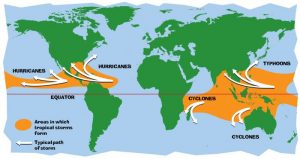How Hurricanes Form
Although beautiful when photographed from space, hurricanes are violent storms that form around the Equator. Their structure is always the same but what makes a hurricane destructive are its fast winds as it moves through water and reaches the coast. The scientific term for these storms is Tropical Cyclone, though depending on its location they are known by different names like Typhoons, Cyclone, and Hurricanes.
Tropical Cyclone Structure:
- The eye of the storm is the center hole, this area is mostly calm.
- The size of the eye of the storm is defined by the eyewall. The winds shaping this cylindrical form are the strongest and most violent.
- The system of clouds spinning and growing forming around the eyewall are called rainbands. These can span hundreds of miles.
- Within this rainbands, towers are the main engines powering the tropical cyclone boosting the air up and providing the energy for the tropical cyclone to keep growing and moving.
“If you could slice into a tropical cyclone, it would look something like this. The small red arrows show warm, moist air rising from the ocean’s surface, and forming clouds in bands around the eye. The blue arrows show how cool, dry air sinks in the eye and between the bands of clouds. The large red arrows show the rotation of the rising bands of clouds.”
How are Tropical Cyclones formed?
In order for a tropical cyclone to form, special circumstances have to be present. It’s development act like a chain reaction, and once the cycle begins, the process can only stop when one of the ‘chains’ breaks and the tropical cyclone can no longer sustain itself.
To form a tropical cyclone a storm needs energy from the warm ocean water. The warm, moist water rises creating tropical thunderstorms and when the winds of these storms start a circular motion and exceed 74 miles per hour the storm is now classified ad a tropical cyclone.
As the warm air rises, it forces surrounding air to move in and up the cyclone, boosted up by the towers. As it moves up it cools and creates more clouds. This process continues to fuel the cyclone until it reaches land. Once a tropical cyclone touches land it can no longer take in warm air and although they still can move far inland, they lose energy, slow down and eventually die off.
The tropical cyclones are classified in a scale of 1 to 5 categories as follows:
| Category | Wind Speed (mph) | Damage at Landfall | Storm Surge (feet) |
| 1 | 74-95 | Minimal | 4-5 |
| 2 | 96-110 | Moderate | 6-8 |
| 3 | 111-129 | Extensive | 9-12 |
| 4 | 130-156 | Extreme | 13-18 |
| 5 | 157 or higher | Catastrophic | 19+ |
Resources For Educators


